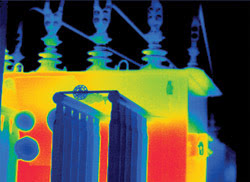New applications result from lower cost, smaller size and increased ease of use.
Tom Scanlon, Flir Systems
Ten years ago, it was ”one size fits all.” We offered infrared technology in a box and hoped to figure out a way to make it work for everybody.
But that’s not what today’s market needs. What we want to do is produce market-specific cameras with market-specific software that makes the product work in existing applications and in new applications that we haven’t addressed in the past. The result of that is product stratification — not one box fits all, but a whole family of products based on different camera platforms that are tuned to meet the needs of specific markets.
Three trends in advanced thermography products are affordability, ease of use and reduced size. New camera families built around uncooled 160 × 120 focal plane array platforms, which are smaller than the traditional 320 × 240 platform, are available. The benefit of using smaller arrays is the ability to build optics and electronics that are more affordable. The new cameras also come with simple user interfaces that enable anybody to learn to operate one within an hour.
New application areas
The thermography cameras are for the first time penetrating markets such as disaster cleanup and building inspection, where they are being used for such problems as finding moisture in buildings. This is a community that has never used infrared cameras on a large scale, but now it is finding that it makes a lot more sense to locate moisture with a $13,000 infrared camera than it does to spend hundreds of hours using an inexpensive moisture meter. Other users of these smaller, more affordable cameras include maintenance engineers, marine surveyors, veterinarians, state departments of transportation, roofing inspectors, and police and security personnel.

This infrared thermograph of an anomalously hot transformer in an electrical substation was captured by an autonomous, networked ThermoVision A20 camera. The camera can be configured to send an e-mail or pager message, alerting personnel about a condition. Courtesy of Wright-Hennepin Cooperative Electrical Association and MiniMax Corp.
Also on the market is a line of “smart” thermographic cameras that are plug-and-play, Transmission Control Protocol/Internet Protocol and FireWire networkable and remotely configurable, and that offer numerous autonomous outputs. New customers are catching on to the use of these cameras in the utility industry, and others are using them for security and condition-monitoring applications.
The next trend we’re starting to see is their use in automated environments. As the ease of use and the affordability continue to improve, more and more smart infrared cameras will be deployed into production line monitoring and automation applications.
Meet the author
Tom Scanlon is vice president of Americas sales for Flir Systems in North Billerica, Mass.